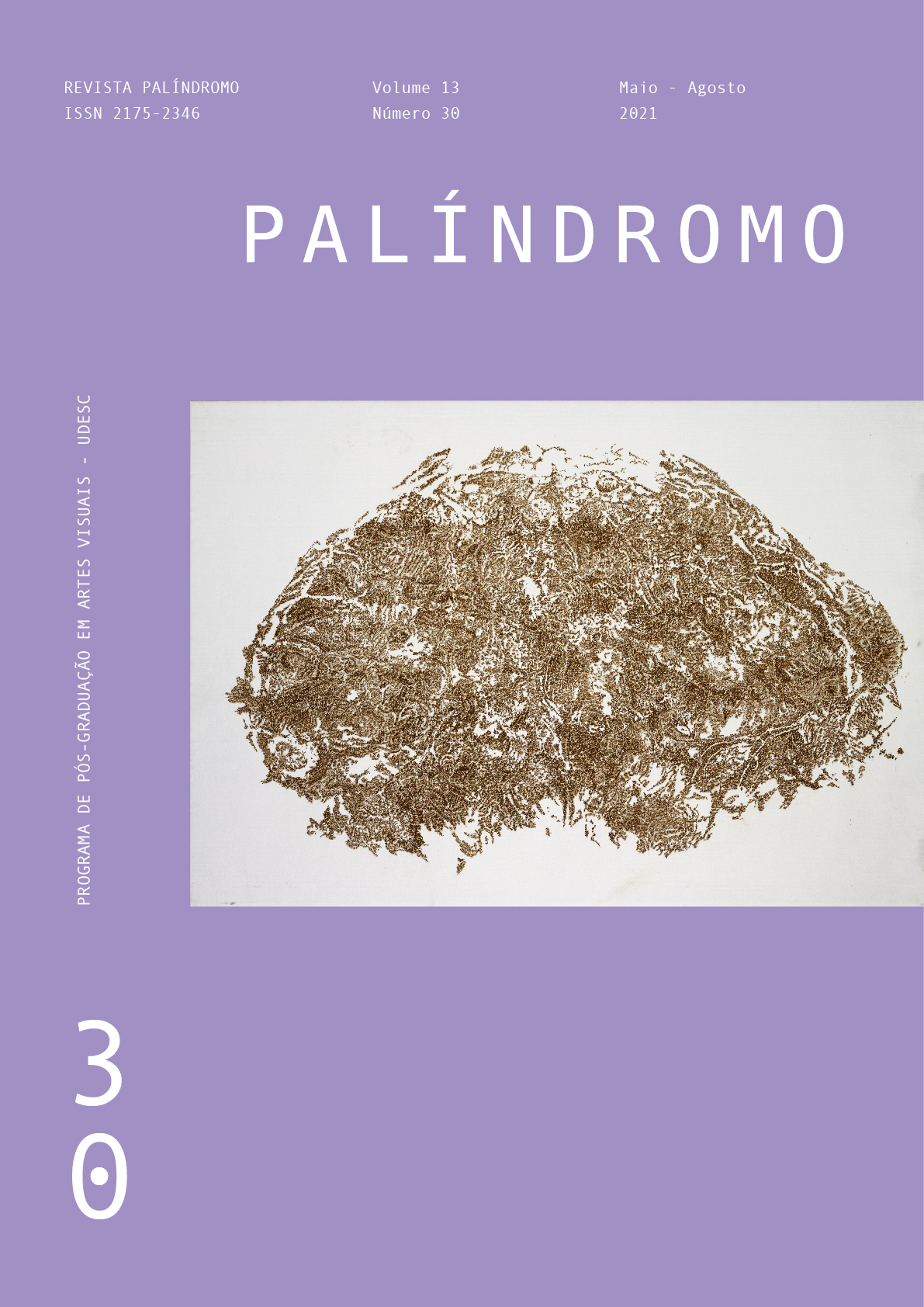Fazer mundos, fabricar possíveis: práticas do artista do fingere
DOI:
https://doi.org/10.5965/2175234613302021169Parole chiave:
mundos possíveis, fingere, imagem-ficção, fotografia contemporâneaAbstract
Este texto tem como objetivo discorrer sobre as motivações que me ligam à pesquisa teórica e prática em artes visuais que tenham implicações coletivas. Após uma breve introdução ao meu percurso de artista-pesquisadora, uma contextualização das disciplinas teóricas com as quais me envolvo é apresentada a fim de iniciar uma reflexão acerca da imagem fotográfica, no contexto da arte contemporânea, e sua produção de instantes, alinhada a um tempo aiônico coerente com sua lógica de manipulação. A teoria dos mundos possíveis visuais norteia essa reflexão, na qual as noções de “fingere” e de “imagem-ficção” se destacam. Um estudo de caso é apresentado, a partir do trabalho do artista Éric Baudelaire, que articula ambiguidades da imagem para pensar as potências do falso na re-construção de outras versões da dita realidade. Conclui-se que a imagem (pós-)fotográfica contemporânea transita entre três graus: o evento original, o histórico e o de imagem. Este último se vale da potência modificadora de mundos, que a imagem-ficção porta consigo, para estimular o movimento na direção e na criação de novos caminhos coletivos.
Downloads
Riferimenti bibliografici
BAQUÉ, D. Photographie plasticienne, l’extrême contemporain. Paris: Regard, 2004.
BAUDELAIRE, E. Potências do falso. Tradução: Tradução: Lucas Eskinazi e Nina Guedes. ARS, São Paulo, v. 16, n. 33, p. 241-253, ago. 2018. DOI: https://doi.org/10.11606/issn.2178-0447.ars.2018.147968
BAUDELAIRE, E. Eric Baudelaire by Benoît Rossel. BOMB Magazine, 15 jul. 2017. Disponível em: https://bombmagazine.org/articles/eric-baudelaire/. Acesso em: 14 dez. 2020.
BELTING, H. La vraie image: croire aux images?. Paris: Gallimard, 2007.
BETHONICO, M. R. artista que fingere: a manipulação da imagem entre a imanência,
as sobrevivências e a dupla-dobra. 2015. 141 p. Dissertação (Mestrado em Artes) - Escola
de Belas Artes, Universidade Federal de Minas Gerais, Belo Horizonte, 2015. Disponível
em: https://repositorio.ufmg.br/handle/1843/EBAC-A47FYR. Acesso em:
dez. 2020.
BETHONICO, M. R. IMAGE-FICTION, IMAGE-ACTION. Mise en jeu de la photographie
contemporaine entre théorie des mondes possibles et théorie des actes d’image.
523 p. Tese (Doutorado em Artes) - Université Sorbonne Nouvelle Paris III,
Paris, 2019. Disponível em: https://tel.archives-ouvertes.fr/tel-02865326. Acesso
em: 14 dez. 2020.
CARVALHO, J. D. Artes e Mundos Possíveis. Aisthe, Rio de Janeiro, v. 6, n. 10, p. 120-137, out. 2012.
CHÉROUX, C. Fautographie: petite histoire de l’erreur photographique. Crisnée: Yellow Now, 2003.
DELEUZE, G. A imagem-tempo: cinema 2. São Paulo: Brasiliense, 2005.
DELEUZE, G. Logique du sens. Paris: Minuit, 1969.
DUBOIS, P. De l’image-trace à l’image-fiction. Le mouvement des théories de la photographie de 1980 à nos jours. Études photographiques, Paris, n. 34, s.p., jun. 2016.
DURAND, R. L’impératif documentaire. In: Qu’est-ce que la photographie aujourd’hui ? Paris: Beaux-arts, 2009, p. 30-35.
GUNTHERT, A.; POIVERT, M. (org.). L’art de la photographie: des origines à nos jours. Paris: Citadelles & Mazenod, 2007.
GUNTHERT, A. L’image partagée: la photographie numérique. Paris: Textuel, 2015.
FINEMAN, M. Faking it: Manipulated Photography Before Photoshop. New York: Metropolitan Museum of Art, 2012.
LAVOCAT, F. Fait et fiction: pour une frontière. Paris: Seuil, 2016.
LEIBNIZ, G. W. Ensaios de Teodicéia sobre a bondade de Deus, a liberdade do homem e a origem do mal. São Paulo: Estação Liberdade, 2017.
MORTARI, C. A. Introdução à lógica. Sao Paulo: UNESP, 2001. DOI: https://doi.org/10.7476/9788539303199
PAVEL, T. Univers de la fiction. Paris: Seuil, 1988.
POIVERT, M. La photographie contemporaine. Paris: Flammarion, 2002.
ROUILLÉ, A. La photographie: entre document et art contemporain. Paris: Gallimard, 2005.
Downloads
Pubblicato
Come citare
Fascicolo
Sezione
Licenza
Copyright (c) 2021 Marina Romagnoli Bethonico

TQuesto lavoro è fornito con la licenza Creative Commons Attribuzione 4.0 Internazionale.
DECLARAÇÃO DE DIREITOS AUTORAIS
a. Os artigos publicados pela revista são de uso gratuito, destinados a aplicações acadêmicas e não comerciais. Todos os direitos autorais são atribuídos à revista. Os artigos cujos autores são identificados representam a expressão do ponto de vista de seus autores e não a posição oficial da Revista Palíndromo. O (s) autor (es) compromete-se sempre que publicar material referente ao artigo publicado no Palíndromo mencionar esta publicação da seguinte forma:
Este artigo foi publicado originalmente pela revista Palíndromo em seu volume (coloque o volume), número (coloque o número) no ano de (coloque o ano) e pode ser acessado em: http://www.revistas.udesc.br/index.php/palindromo
b. Plágio, em todas as suas formas, constitui um comportamento antiético de publicação e é inaceitável. A revista Palíndromo utiliza o software iThenticate de controle de similaridade


